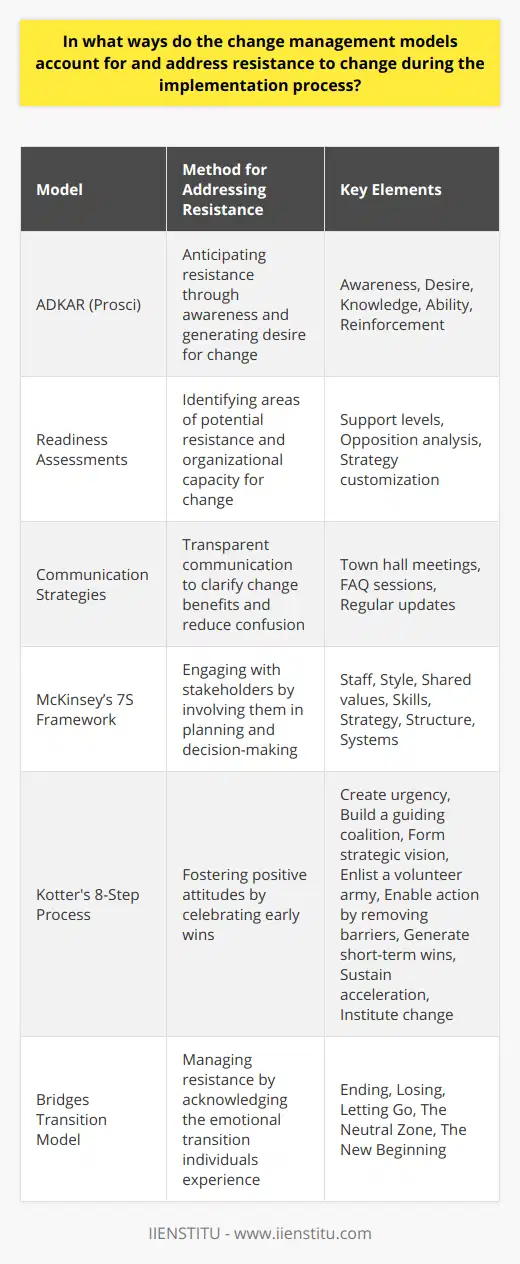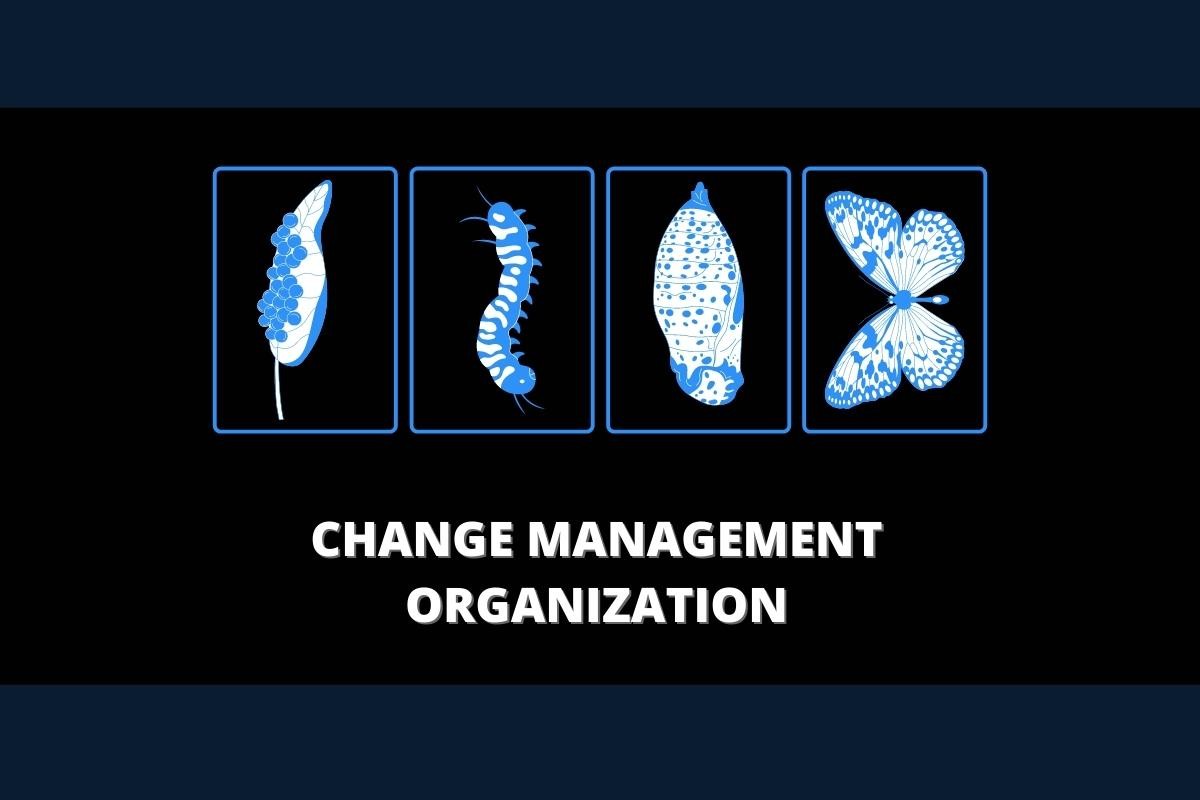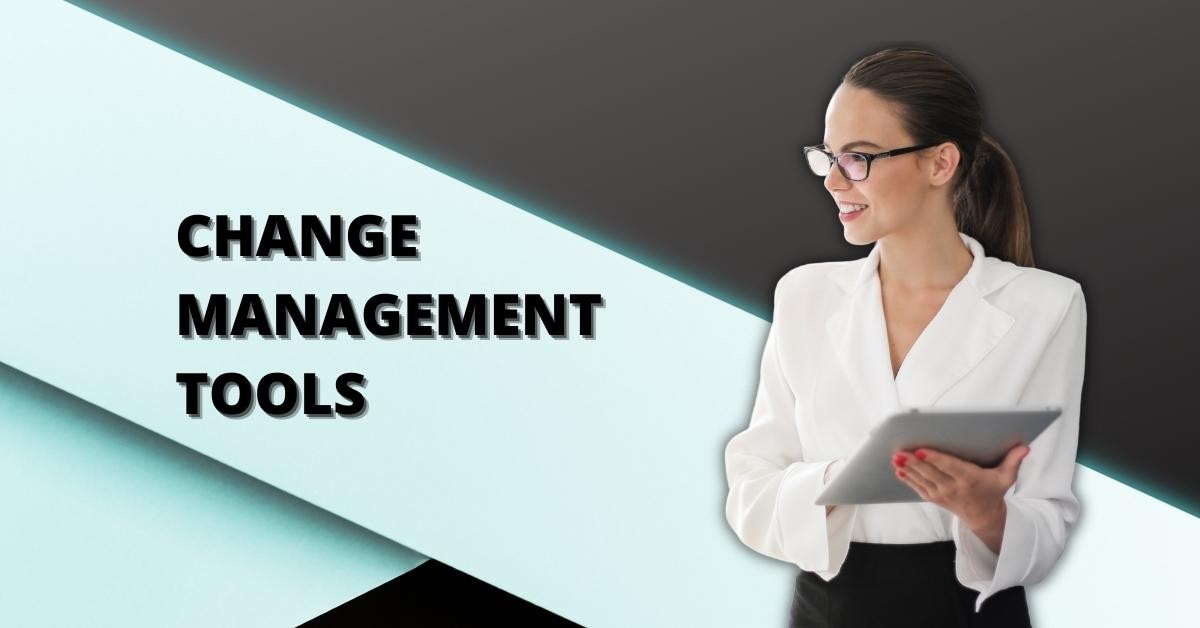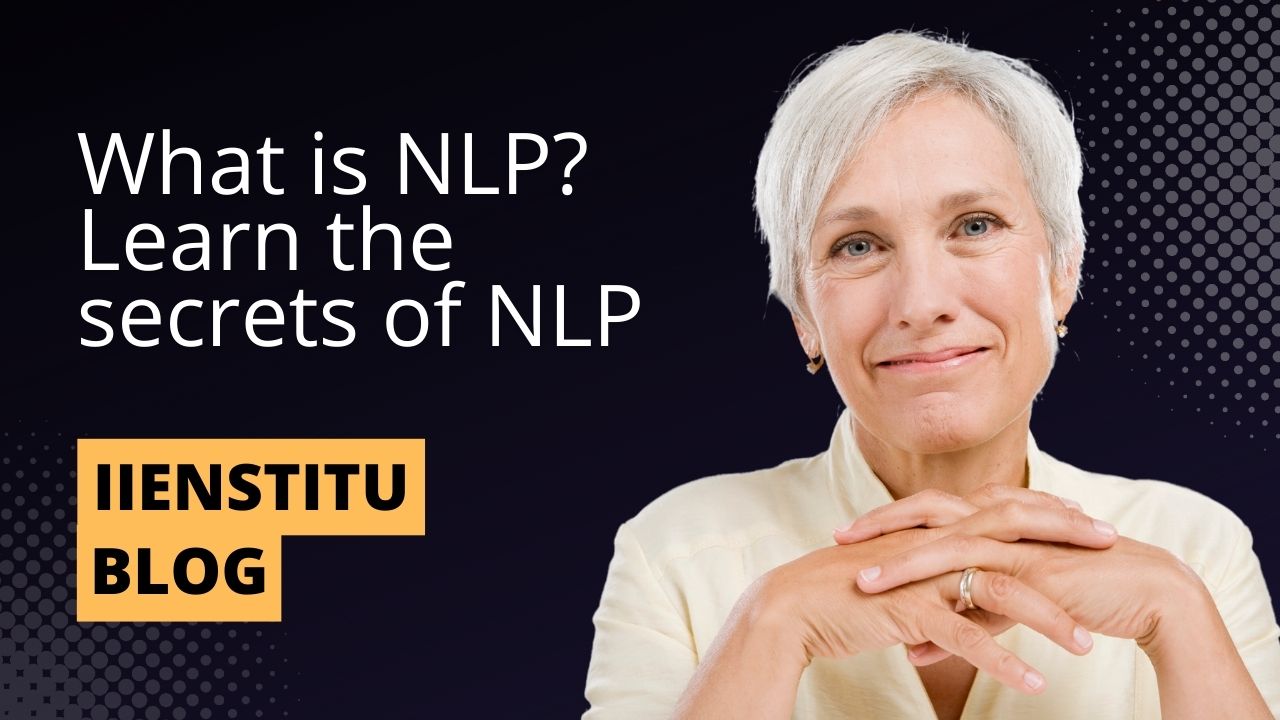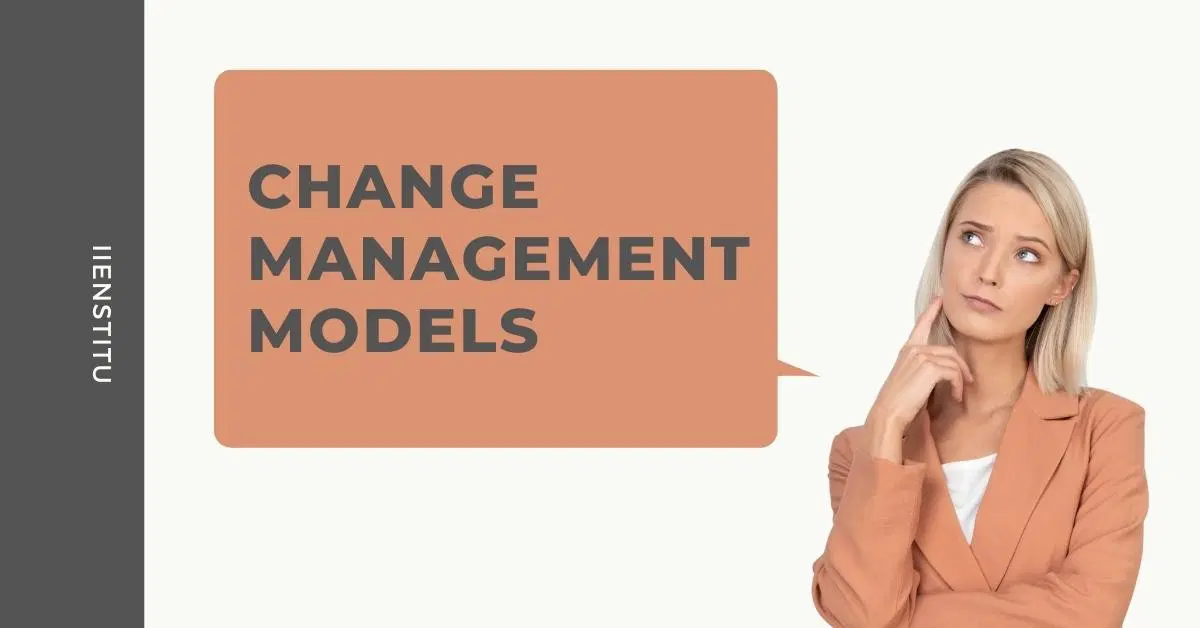
There are an endless number of change management models, but they all have the same goal: to make organizations efficient and effective. This does not mean you should use whichever model your favorite consulting firm advises for their piece-of-cake project; rather it's about understanding what kind of problem each pattern solves with its various techniques before deciding which will be best suited towards solving yours in order save time during implementation as well as avoid mistakes that may lead down unsuccessful paths like confusing stakeholders with inaccurate information or wasting resources on unproductive projects.
What are The Change Management Models?
Linear Model :This is the simplest and most often used model: an idea, a plan, and its implementation. It can be applied to small and complex projects alike. Using this model (which we will call linear) we follow these steps:
Idea —> planning —> action —> feedback loop —> change in plans (repeat as necessary)
Linear models are best suited for simpler situations where the risks of failure are low such as business as usual (BAU), improvement (KAIZEN), or maintenance projects.
Generally speaking it's not recommended that you use linear models for innovative projects as there is a high risk of failure. However, it can be used in special cases where the organization wants to maintain the status quo.
Diverging / Converging Model: This model (which we will call diverging / converging) is another common model that can be used for small and complex projects alike. It follows these steps:
Idea —> planning —> divergence into options —> convergence on a plan —> action —> feedback loop (repeat as necessary)
Diverging / converging models are best suited for situations where change is desired such as product development, marketing campaigns, or new business ventures. The main advantage of this model is that it allows for flexibility and creativity, however the risk of failure is also higher. This model can be used in conjunction with linear models for innovative projects where both high risks and rewards are involved.
Unlocking Success in Organizational Change Management: A Comprehensive Guide
Mastering Control Charts for Change Management: Benefits, Types, Examples & More
The Power of Learning Organizations in Driving Change Management Success
This model has some important caveats: it does not exclude the option to go back and forth between divergence and convergence (back and forth), nor does it necessarily mean that we end up with one solution; we may end up with several options —> pick our favorite —> go back to divergence —> converge on a new plan—>action. Although this will add time and effort on implementation , if done correctly, it can save you from making costly mistakes by testing out your ideas on a smaller scale before implementing them more broadly. It's best to make sure you have a good idea of the risks involved, determine a threshold at which you will stop going back and forth, and ensure that all necessary preparations are in place before continuing with the actual implementation.
Summarize
1.The One and Done Model
2. The Incremental Model
3. The Immediate Action Model
4. The Strategic Change Management Model
The One and Done Model
The one and done model is a change management model in which changes are made by a single individual, without any middlemen getting involved in between initial ideas and finished products. This makes it easier to manage changes, as there is less opportunity for things to go wrong.
When you're managing changes yourself, you don't have to worry about other people's opinions or feedback. You can make changes directly to the product, and see how they work before deciding whether or not to keep them. This can be especially useful when you're working on a prototype or a beta version of a product.
The one and done model also has the advantage of being more efficient. There is no need for multiple rounds of feedback and revision, as everything is done in a single step. This can save time and money, and it can also help to speed up the development process.
However, the one and done model does have some disadvantages. It can be more difficult to make changes when you're working on a complex product, and it's also more difficult to get feedback from others. It's important to remember that the one and done model is not perfect, and it should not be used in every situation. However, it can be a useful tool for managing changes in a fast and efficient way.
The Incremental Model
The incremental model is a process that enables organizations to make small, manageable changes in their work environments. These are often implemented as "increments" and can be completed one step at time with little or no risk of disrupting business operations because they only affect specific tasks within an individual job role rather than entire departments (or even groups).
This type of change management is especially beneficial for businesses that are experiencing rapid growth or those that are making the transition from a traditional to a more modern way of working. Incremental changes can help to gradually shift employees' behaviors and processes so that everyone is comfortable with the new way of doing things before it's fully implemented.
Additionally, incremental changes allow for more flexibility and adaptability, which can be essential in fast-paced and ever-changing industries. By making small changes that can be easily adapted to new circumstances, businesses can avoid the costly mistakes that can often be associated with large-scale transformations.
Ultimately, the incremental model is a great way to introduce change gradually and ensure that it's implemented in a way that is both manageable and effective. If you're looking for a way to make changes in your organization without risking business operations, the incremental model is definitely worth considering.
The Immediate Action Model
Implementation of any change is always a very complex matter. It requires time, attention and patience from all the involved parties in order to accomplish successfully. However, this process can be accelerated when making use of the immediate action model. This approach enables people to make quick decisions while still involving them in the whole process while also providing them opportunities for feedback during decision-making throughout certain stages so that there won't be any surprises when it comes down time executing on those ideas/services etc...
The immediate actions model has been designed under the assumption that projects are divided into three broad categories. Firstly, this model should be used before projects are launched or even conceived. The second approach would be for managing existing projects or within your organization's structure while finally, this model can be used to manage projects that have been terminated.
Decision-making is a process where many different people are involved and their decisions, as well as the timing of those decisions, will affect how much effort needs to go into making those changes happen. This decision-making process could include the involvement of job functions from across an organization from finance/accounting, operations, sales/marketing and human resource departments either by invitation or proposition. They should all contribute towards a solution together in order to help the project move forward successfully through its various stages throughout implementation which involves several key components such as preparing for change management to actualizing that change then finally redefining what you've implemented for future reference etc...
In order to accomplish this, the immediate action model has three fundamental steps. The first one is "information gathering" which is about understanding the issue at hand and collecting all the relevant data in order to make an informed decision. Once that's done, you move on to the "analysis" stage where you'll need to assess all of the gathered information in order to come up with potential solutions. The last step is "implementation" where you put the chosen solution into action.
Throughout these three steps, it's important that feedback is constantly solicited from those involved as it will help improve both the quality of decisions as well as the speed of implementation. This feedback can come from a variety of sources such as team members, department heads, customers or anyone else who might be able to offer a fresh perspective on the issue as it's directly related to their line of work.
So, as you can see there are some great advantages associated with making use of the immediate action model. One such advantage is its capacity for increasing stakeholder engagement by involving them in the decision-making process and also providing them opportunities for feedback throughout development which ensures everyone is very much up-to-date on how things are progressing and more importantly exactly where they're headed once it comes time to start executing on those ideas/services etc...
The immediate action model is an approach that should be used when your organization wants to move quickly and at the same time involve people from all over without having any hidden surprises when it actually becomes time to start executing on those ideas/services.
The Strategic Change Management Model
The Strategic Change Management Model has entails five key elements. It involves developing a feasible strategy to execute on your planned changes while also considering other factors such as company culture or economics at work in order to find an effective solution that you can both live with long term.
1) Communicate the goal
2) Assess risks and opportunities for change
3) Develop a feasible strategy to execute on your planned changes
4) Consider other factors such as company culture or economics at work
5) Find an effective solution that you can both live with long term.
A big part of any successful business is looking ahead and preparing for future challenges, but this can be difficult when conditions are constantly changing. The Strategic Change Management Model provides a framework for planning and implementing changes in a way that minimizes risk and maximizes opportunity.
The first step is to communicate the goal of the change initiative to all stakeholders. This includes making sure everyone understands why the change is necessary, what specific objectives are being sought, and how everyone will benefit from its successful implementation. Once everyone is on board, it's time to assess the risks and opportunities for change. This involves looking at all potential implications of making the change, both good and bad, as well as considering any possible ways to capitalize on new opportunities that may arise
Once a clear strategy has been developed, it's time to put it into action. This involves creating an action plan with specific steps, roles and responsibilities assigned to each team member. Having clear guidelines will prevent any potential misunderstandings or confusion later on that could derail the project. Finally, it is important to determine how success will be measured and monitored throughout the change process. This will help ensure all expectations are met & everyone's efforts align towards achieving common goals.
Here's what your successful change initiative should accomplish:
1) Clearly defined goal(s)
2) A feasible strategy for executing on your planned changes
3) Mitigation of risks associated with making the changes being implemented
4) A plan in place for capitalizing new opportunities created by making the changes being implemented
5) Measurable objectives to track progress and ensure the changes are having the desired effect
Follow these five steps and your next change initiative will be off to a successful start!
The Strategic Change Management Model is a great way to plan and execute changes in a way that minimizes risk and maximizes opportunity. By communicating the goal of the change initiative to all stakeholders, assessing the risks and opportunities for change, developing a clear strategy, and putting a plan in place with specific steps, roles and responsibilities assigned, you can make sure that everyone is on board and understands what is expected of them. This will help ensure that the change process runs smoothly and that everyone's efforts are aligned towards achieving common goals. Successfully implementing changes can be difficult, but by following the Strategic Change Management Model, you'll be well on your way to a successful change initiative!
Questions
1) What are the most effective techniques for implementing organizational change?
2) Are all of these techniques appropriate for every organization, or does your company have a different strategy that you owe it to yourself to implement?
3) Is it necessary for an employee's attitude to change in order for them to be more open about change?

Frequently Asked Questions
What is linear model?
This is the simple of change management model. But there can be risks. Because quite simple model.
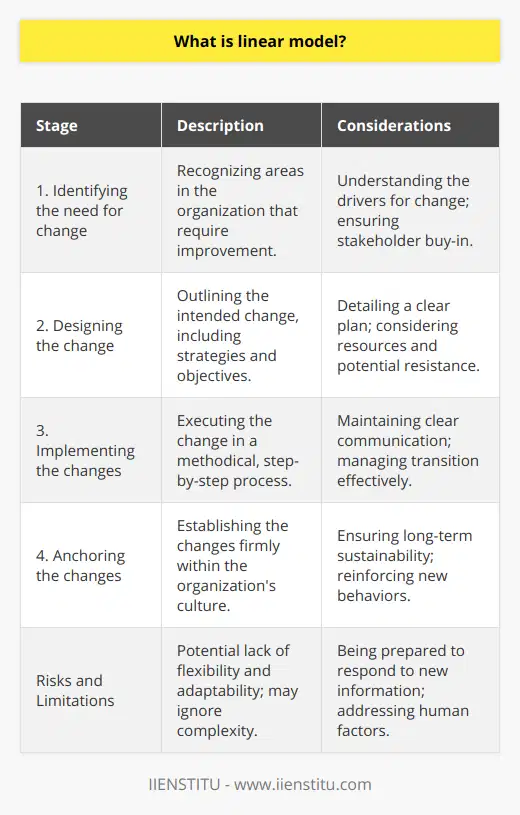
What are the change management models?
Linear Model, Diverging and Converging Model, The One and Done Model, The Incremental Model, The Immediate Action Model, The Strategic Change Management Model
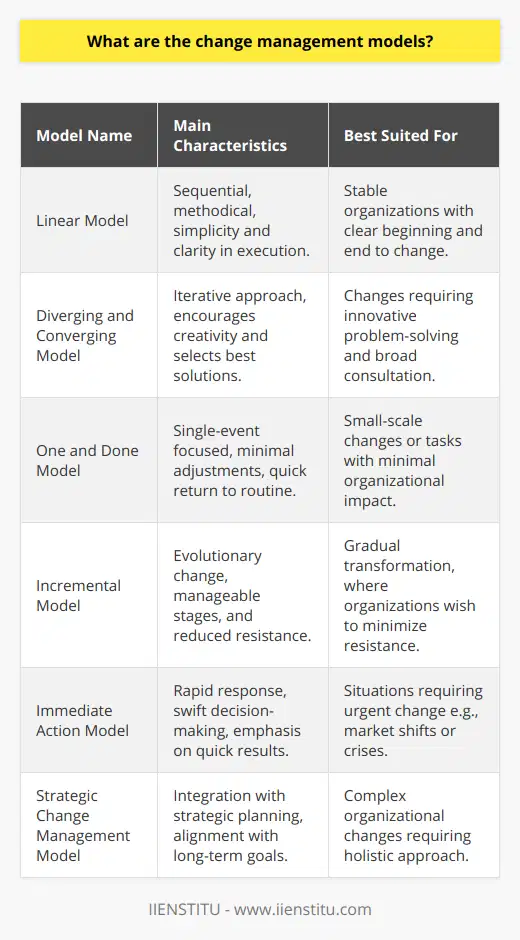
What is the immediate action model?
There are 3 steps in this model: First information gathering, second analysis, the last one implementation.
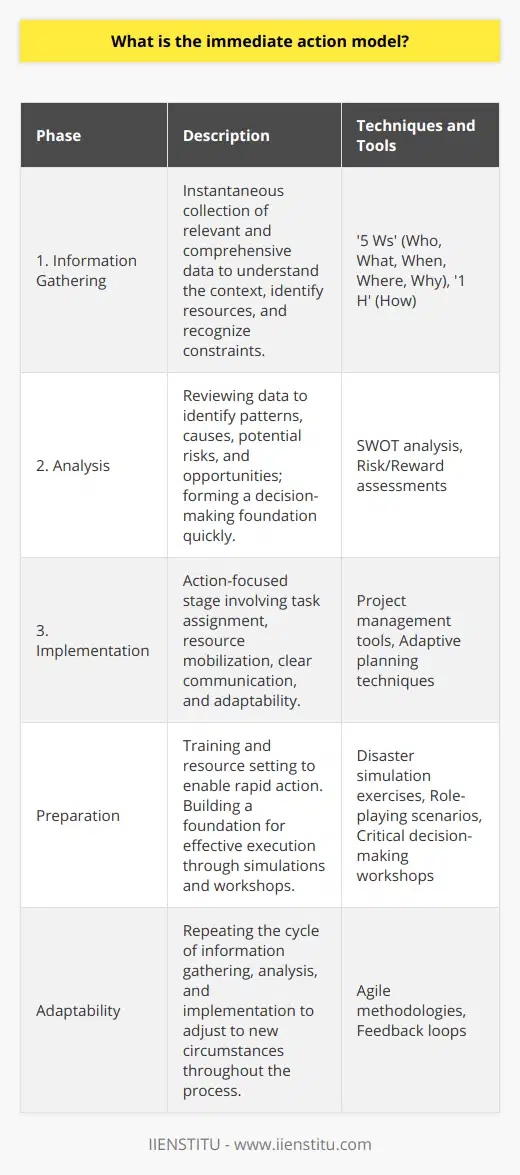
What is the difference between various change management models and their applications?
Understanding Change Management Models
Change management models refer to the structured approaches and methodologies that organizations use to facilitate and manage changes within their processes, systems, and structures. These frameworks help businesses adapt to new circumstances, minimize disruption, and ensure that adjustments are sustainable and successful.
Diversity in Change Management Models
There are several change management models, with each offering distinct strategies and tools to guide an organization through change. Some of these models include Lewin's Change Management Model, Kotter's 8-Step Process, ADKAR Model, and McKinsey 7S Model. Their goals may be similar, but their approaches and focuses differ significantly.
Lewin's Change Management Model
Kurt Lewin's model emphasizes the importance of understanding the human aspect of change. It comprises three stages: unfreezing, change, and refreezing. Unfreezing involves breaking down existing mindsets and overcoming resistance. The change stage is where the actual transition occurs, and refreezing is the consolidation and reinforcement of the new state.
Kotter's 8-Step Process
John Kotter's framework focuses on leading organizations through strategic transformations. It outlines eight sequential steps: creating a sense of urgency, forming a guiding coalition, developing a vision and strategy, communicating the change, enabling and empowering action, generating short-term wins, consolidating gains, and anchoring the change in culture.
ADKAR Model
The ADKAR model, developed by Jeff Hiatt, is designed to support individual change within an organization. This acronym stands for Awareness, Desire, Knowledge, Ability, and Reinforcement. The model contends that for change to be successful, individuals must progress through each of these stages.
McKinsey 7S Model
The McKinsey 7S Model focuses on seven interrelated factors to ensure organizational effectiveness during change. These factors are strategy, structure, systems, shared values, skills, style, and staff. The model proposes that changes must be aligned across all these elements for a successful and coherent transformation.
Selecting the Appropriate Model
There is no one-size-fits-all change management model, as each organization faces unique challenges and circumstances that may require different strategies. Choosing the most suitable model depends on factors such as the nature of the change, the size and complexity of the organization, the human dynamics involved, and the desired outcome. By understanding the key differences between these change management models, organizations can make informed decisions on the most effective approach to navigating and implementing change.
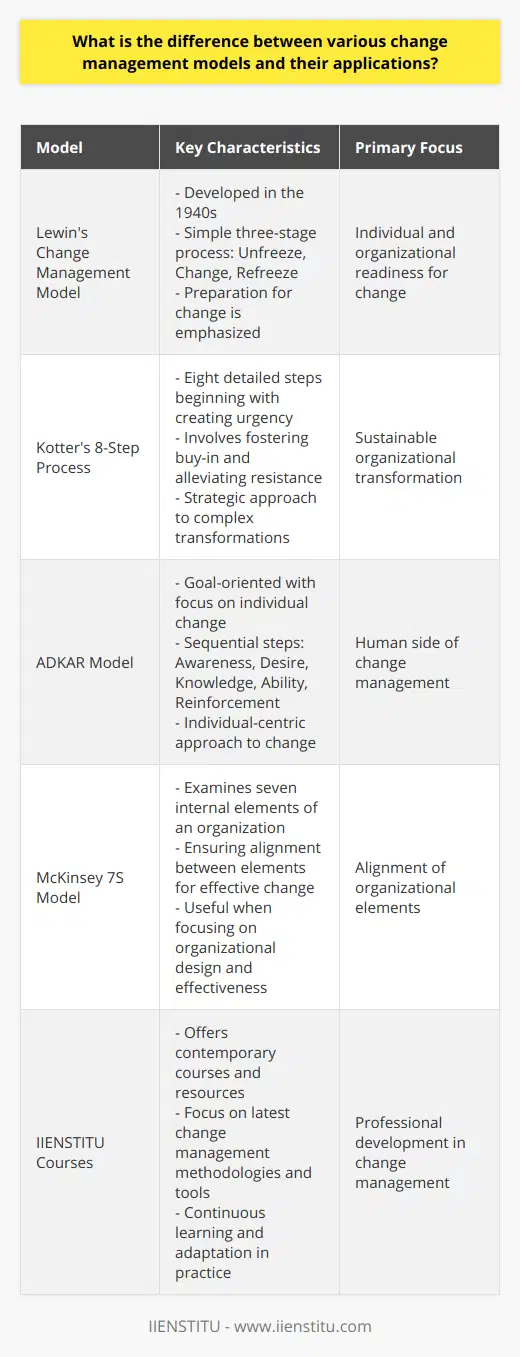
How do the 3 change models compare to the 7 model of change management in terms of effectiveness and efficiency?
Comparing Change Models: Effectiveness and Efficiency
Change Management Models
When examining change management, researchers have developed various models to help organizations navigate through the transition process. Three popular models include Kotter's 8-Step Model, Lewin's Change Management Model, and ADKAR, while another seven factors based model, McKinsey 7S model, expands on these concepts.
Effectiveness of Three Change Models
The effectiveness of each model can be evaluated by assessing the degree to which they facilitate successful organizational change. Kotter's 8-Step Model focuses on creating a sense of urgency and fostering a culture of adaptability. Lewin's Model adopts a more structured approach, emphasizing the need to unfreeze, change, and refreeze behaviors. ADKAR, on the other hand, centers on individual change through awareness, desire, knowledge, ability, and reinforcement.
Efficiency of Three Change Models
From an efficiency standpoint, each model varies in their approach. Kotter's model requires a more substantial time investment due to its intricate step-by-step process. Lewin's Model is less time-consuming, as it focuses on stabilizing the organization through transitions. ADKAR is efficient in emphasizing individual change, allowing for quicker adoption of new practices.
McKinsey 7S Model: A Comprehensive Approach
The McKinsey 7S Model is a comprehensive framework that combines the elements of the three aforementioned change models. It revolves around seven interconnected factors: strategy, structure, systems, shared values, skills, style, and staff. This model offers a holistic perspective by considering both internal and external organizational factors.
Effectiveness and Efficiency of the 7S Model
In terms of effectiveness, the 7S Model addresses a wide range of organizational aspects, allowing for the successful implementation of change by addressing potential gaps and issues. Its comprehensive nature ensures that change is managed in a well-rounded manner, focusing on not just the process but the people as well.
For efficiency, the 7S Model might require more time and resources initially, due to its multifaceted approach. However, it offers long-term efficiency gains by aligning different aspects of an organization, optimizing performance, and ensuring successful change implementation.
Conclusion
In conclusion, the three popular change management models (Kotter's, Lewin's, and ADKAR) offer various degrees of effectiveness and efficiency depending on the organization's needs and change requirements. While the 7S Model may require more upfront investment in time and resources, it offers a holistic approach that better addresses long-term success in change implementation. Ultimately, choosing the most suitable model for a specific organization depends on the unique requirements and objectives related to the desired change.
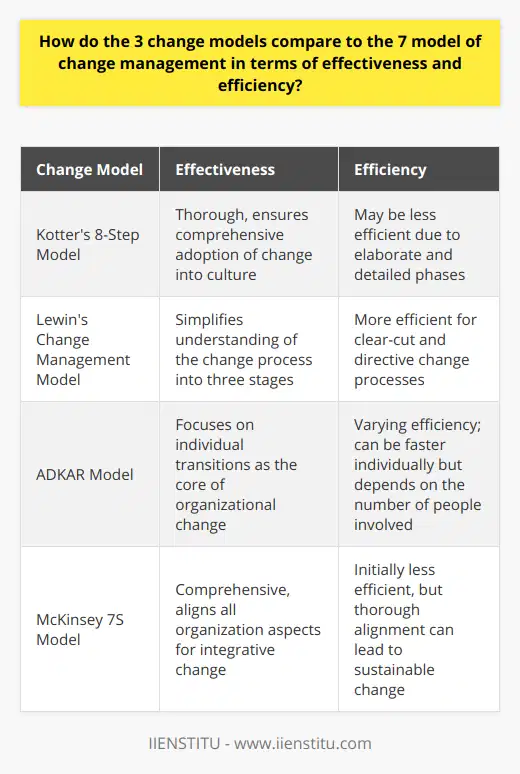
Can you explain the relationship between the 4 stages change management model and the underlying theories supporting each stage?
The Change Management Model
The four stages of the Change Management Model are crucial in understanding the underlying theories supporting each stage. The model provides a framework to prepare, manage, and reinforce change, ultimately leading to successful organizational transformation.
Stage 1: Preparing for Change
The first stage focuses on creating awareness and building a readiness for change within the organization. This stage is guided by theories such as Kotter's Eight-Step Process, which emphasizes the importance of creating a sense of urgency, establishing a guiding coalition, and developing a shared vision. Another theory, the ADKAR Model, highlights the need to address individual employee awareness, desire, knowledge, ability, and reinforcement to facilitate change effectively.
Stage 2: Managing the Change
The second stage involves facilitating and implementing the change initiatives. Prosci's Three-Phase Process is one relevant theory that highlights the value of initiating, managing, and consolidating change. Lewin's Change Management Model, another supporting theory, highlights a three-step process of unfreezing, changing (or moving), and refreezing for managing change. These theories advocate for clear communication and employee engagement to ensure seamless change execution.
Stage 3: Reinforcing Change
The third stage pertains to sustaining and reinforcing the change efforts. This stage is strongly supported by the concept of continuous improvement, as derived from the Plan-Do-Check-Act (PDCA) model. Continuously evaluating the outcomes, gathering feedback, and implementing corrective actions are key to ensuring that the change leads to the desired results. An additional theory, Reinforcement Theory, emphasizes the need to provide positive reinforcement and rewards to encourage desired behaviors and consolidate new practices.
Stage 4: Reviewing and Adapting
The final stage emphasizes the need to review the change outcomes and adapt accordingly. Theories such as Appreciative Inquiry focus on building upon the existing strengths and assets of the organization rather than solely concentrating on problem-solving. Furthermore, Double-Loop Learning, another pertinent theory, highlights the importance of evaluating and challenging the underlying assumptions and beliefs during the change process, allowing for the possibility of adapting and refining the change initiatives.
In conclusion, the four stages of the Change Management Model are essential in grasping the relationship with the theoretical foundations supporting each stage. A holistic understanding of these theories enables organizations to better plan, execute, and sustain successful change initiatives.
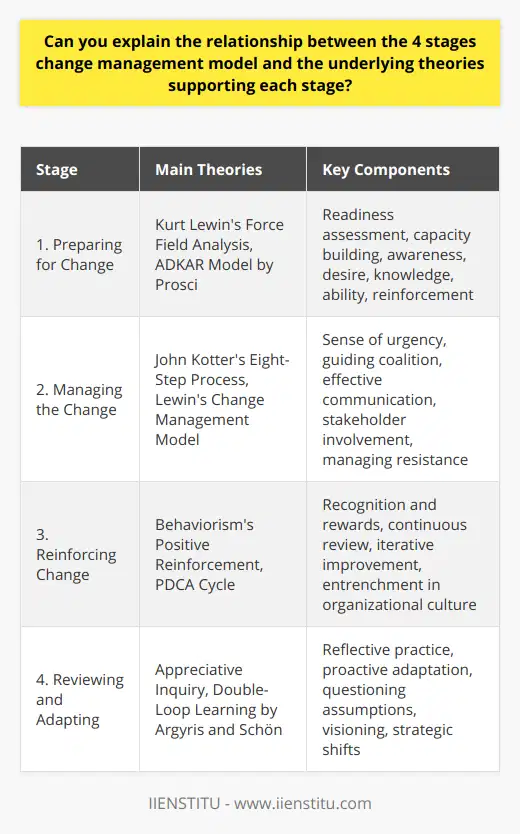
What are the key differences between the 3, 4, and 7 models of change management in terms of their approach and applicability to different situations?
Key Differences in Approach
The 3, 4, and 7 models of change management differ significantly in terms of their approach to managing organizational change. The 3-step model, developed by Kurt Lewin, consists of unfreezing, transition, and refreezing. This sequential process emphasizes the need to create awareness of change and the importance of stabilizing new behaviors within the organization. The 4-step model, commonly known as ADKAR, consists of awareness, desire, knowledge, ability, and reinforcement. This model focuses on individuals within the organization, addressing their unique requirements throughout the change process.
Seven-Step Approach
The 7-step model, also known as the McKinsey 7S model, is a more comprehensive approach to change management that considers strategy, structure, systems, staff, skills, style, and shared values. This holistic approach recognizes the interconnectedness of these elements and the importance of aligning them to achieve successful change. This model is particularly useful for examining the internal aspects of an organization and identifying areas for improvement.
Applicability to Different Situations
When it comes to applicability, the 3-step model is often utilized for smaller-scale changes as it simplifies the process and can be easily communicated to stakeholders. However, the simplicity of this model can also be a limitation as it may not address the complex and intertwined elements that may be involved in larger-scale organizational changes.
Individual vs. Organizational Focus
Conversely, the 4-step ADKAR model is useful for addressing the needs of individual employees during the change process. This model is particularly beneficial when employee resistance to change is expected, as it emphasizes the importance of gaining buy-in from staff members. However, focusing heavily on individuals may sometimes neglect the broader organizational context and structure.
Holistic Analysis for Complex Changes
The 7-step model is most applicable to complex, large-scale changes, as it provides a comprehensive analysis of the organization's internal elements. This model is effective at identifying potential barriers to change and serves as a diagnostic tool for management. Nonetheless, its complexity may prove challenging for smaller organizations or those with limited resources.
In conclusion, the 3, 4, and 7 models of change management offer varying approaches based on the scale and complexity of the change, as well as the level of focus on individuals versus broader organizational elements. Choosing the appropriate model depends on the specific context and requirements of each organization and change initiative.
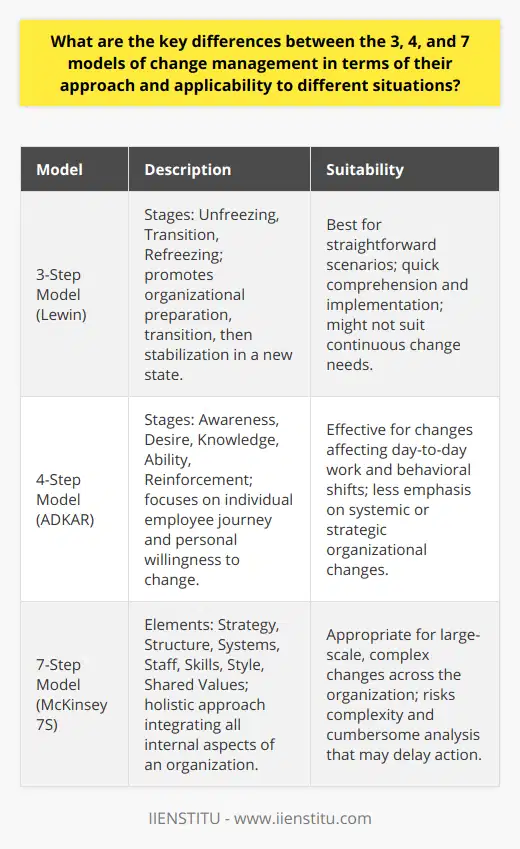
What are the theoretical foundations of the 5 components of change management model and how do they influence the overall success of organizational change?
Theoretical Foundations of the Model
The 5 components of change management model have various theoretical foundations that influence the overall success of organizational change. These foundations help understand the underlying mechanisms and provide a framework to manage and implement change effectively.
Awareness of the need for change
The first foundation is rooted in Lewin's Change Theory, which highlights the importance of recognizing the need for change and creating a sense of urgency among stakeholders. Individuals and organizations must become aware of the potential benefits and consequences of staying in the status quo to drive the change process successfully.
Desire to participate in and support the change
The second foundation lies in the Expectancy Theory, which emphasizes the individual's motivation to support and participate in change. Efforts to change are more likely to succeed when employees believe that the change is achievable, worthwhile, and beneficial for their personal and professional development.
Knowledge of how to change
Learning theories, particularly Situated Learning and Transfer of Learning, provide the foundation for this component. Change requires individuals to acquire new knowledge, skills, and competencies in a supportive environment. When employees see the relevance of these new skills and can apply them in their context, they become more committed to the change process.
Ability to implement the change
This component is based on the Capability Maturity Model Integration (CMMI), focusing on developing abilities and capacities to implement change at different levels within the organization. Through continuous improvement, organizations can optimize their processes, increase efficiency, and better support change initiatives.
Reinforcement to sustain the change
The final foundation is grounded in the concepts of reinforcement and feedback. According to the Social Cognitive Theory, reinforcement helps individuals and organizations internalize new behaviors, maintain motivation and commitment to change, and develop a culture that supports continuous improvement.
In conclusion, the theoretical foundations of the 5 components of change management model provide a comprehensive understanding of the factors that influence the overall success of organizational change. By creating awareness, fostering desire, developing knowledge and abilities, and reinforcing new behaviors, organizations increase the likelihood of a successful change implementation.
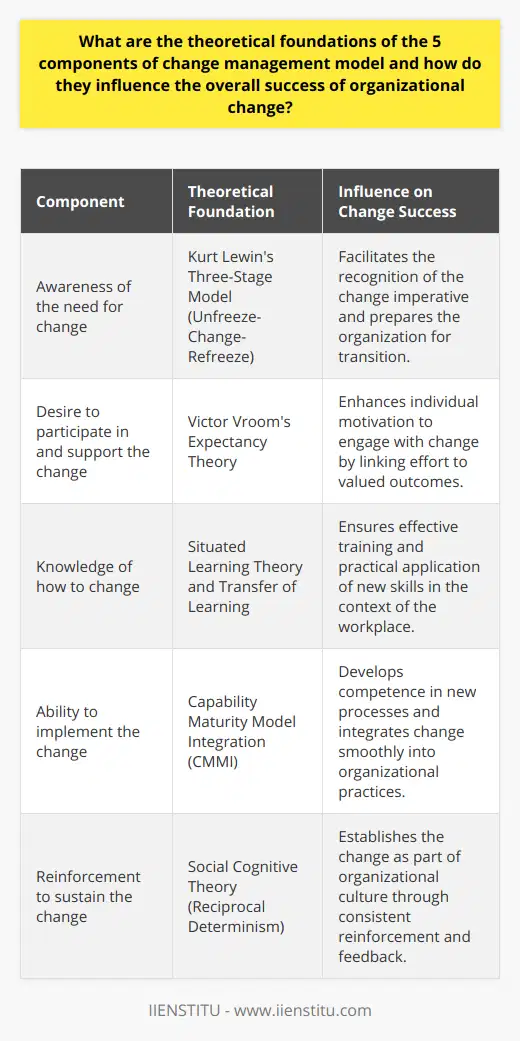
How can the choice between the 3, 4, and 7 models of change management be optimized for varying organizational scenarios, taking into account factors such as size, complexity, and nature of required change?
Organizational Context and Change Model Selection
Optimizing the choice between the 3, 4, and 7 models of change management for varying organizational scenarios requires considering factors such as size, complexity, and required change nature. It is crucial to analyze these aspects in order to implement effective transitions while minimizing potential risks.
Size and Scope of the Organization
The size of an organization plays a significant role in determining the appropriate change management model. In large organizations, the 7-model approach, which involves more extensive planning, communication, and stakeholder involvement, may be more suitable. Smaller organizations may find the 3 or 4-model approach more suitable, given their agility and fewer layers of decision-making.
Complexity of Required Change
Complex changes, such as mergers or the implementation of new technology, may benefit from a more comprehensive framework like the 7-model. This approach assists in addressing diverse aspects and potential challenges associated with intricate undertakings. Conversely, less complex changes, like policy revisions or minor procedural adjustments, might be more efficiently addressed using the more streamlined 3 or 4-model approach.
Nature of Required Change
The nature of the required change will also influence the choice of change management model. Strategic, high-impact changes may need a structured approach offered by the 7-model. This model allows organizations to assess readiness, devise detailed action plans, and monitor progress. On the other hand, operational and more tactical changes may benefit from the simplicity and efficiency of the 3 or 4-model approach.
Cultural and Industry-specific Considerations
The choice of change model should also account for the organization's culture and industry-specific characteristics. For instance, companies operating in highly regulated industries may need more rigorous change management approaches to ensure compliance. Additionally, organizations with a more bureaucratic culture may benefit from the structured nature of the 7-model, while those with a more flexible culture may find the 3 or 4-model approach more feasible.
In conclusion, selecting the optimal change management model depends on the unique characteristics of each organization and the specific transformation they seek to undertake. Carefully considering factors such as organizational size, complexity of change, and the nature of the required transition will guide decision-makers in choosing the most suitable model, ensuring a successful change implementation.

What are the key factors to consider when selecting an appropriate change management model for a specific organizational context?
Organizational Needs
When selecting a change management model, first consider the unique needs of your organization. These needs include the scale and scope of change, current processes, culture, and available resources.
Change Magnitude and Nature
Assess the extent and form of change. If your organization is undergoing large-scale, systemic change, then a comprehensive model like Kotter’s 8 Step model may be more appropriate. If the changes are incremental and continuous, a leaner model like the ADKAR might be a better fit.
Organizational Culture
Consider the culture of the organization. The model should align with your organization’s values, beliefs, and mindset. For example, models that heavily rely on top-down management may not work well in organizations with a collaborative culture.
Readiness for Change
Determine the readiness for change in your organization. A model that includes stages for managing resistance and building buy-in might be more suitable for organizations experiencing high resistance to change.
Knowledge and Skills
Check the knowledge and skills available within your organization. Complex models require more expertise and training. Hence, tailor your selection based on the competency of your employees.
Available Resources
Consider available resources like time, budget, and manpower. Some models may require more resources for successful implementation.
Ease of Implementation
Finally, look at the ease of implementation of the model. Simpler models are easier to implement and understand, thus increasing the chances of success.
In summary, when selecting a change management model, carefully consider factors such as the scale and nature of change, organizational culture, readiness for change, available knowledge and skills, resources, and ease of implementation. Your choice should align with your organizational context to ensure a smooth and successful transformation.

How do the guiding principles and assumptions of the 7-model change management approach compare to the 3-model and 4-model approaches in terms of adaptability and flexibility?
Comparative Analysis: Models of Change Management
A comparative study of the 7-model, 4-model, and 3-model change management approaches reveals distinct differences primarily in adaptability and flexibility.
The 7-Model Approach
The 7-model change management approach encompasses a comprehensive framework. It covers everything from creating a sense of urgency, to consolidating gains and anchoring new approaches. This approach often exhibits high flexibility. This is due to the comprehensive insight that enables organizations to adjust strategies based on changing circumstances.
Comparing with 4-Model Approach
In contrast, the 4-model approach is often less adaptable. Its primary focus is on understanding the change, planning the change, implementing the change, and making the change stick. Lacking the detailed stages inherent in the 7-model approach, the 4-model process might be less responsive to unexpected shifts in business environment.
Comparison with 3-Model Approach
The 3-model approach is arguably the least flexible of the three. It simply emphasizes the phases of unfreezing, changing and refreezing. It may not provide adequate preparation for emerging changes. This approach tends to emphasize stability over adaptability.
Conclusion
Overall, while all three models offer valuable insights into managing transitions effectively, the 7-model approach stands out for its adaptability and flexibility. Its comprehensiveness allows organizations to adapt more efficiently to continuously evolving circumstances. Conversely, the 4-model and 3-model approaches, though simpler, may be less responsive to unexpected changes due to their less extensive frameworks.

In what ways do the change management models account for and address resistance to change during the implementation process?
Understanding Resistance to Change
Change management models play a significant role in navigating resistance during the implementation process. These models account for resistance by acknowledging it as an inevitable part of change.
Proactive Identification of Resistance
The ADKAR model, for instance, emphasizes awareness and desire as the first steps in managing change. These steps help in identifying potential resistance upfront. It anticipates resistance by fostering understanding and cultivating motivation amongst stakeholders.
Strategic Planning for Resistance
The Lewin’s Change Model also addresses resistance, with its 'unfreezing' stage focusing on overcoming resistance. In this stage, organizations carry out preparatory actions. These actions include communication, education, and involvement, aimed at reducing resistance.
Effective Communication
Communication is a common strategy in change management models. It can make stakeholders understand what the change entails. By maintaining transparency, models seek to counter misinformation as well as misconceptions, factors that often lead to resistance.
Engagement and Participation
They also promote direct participation and involvement of stakeholders in the change process. By engaging people, especially those directly affected by proposed changes, they help reduce anxiety and resistance.
Promotion of Positive Perception
Furthermore, change management models try to create a positive perspective of change. Using the Kotter’s 8-Step Process, they ensure visible, quick wins to build momentum, fostering positive perception and reducing resistance.
In conclusion, effective change management models account for resistance by anticipating it, addressing it through strategic planning, effective communication, stakeholder participation, and fostering a positive perception of change. They consider resistance not as an obstacle but as a guidepost to support successful change implementation.
